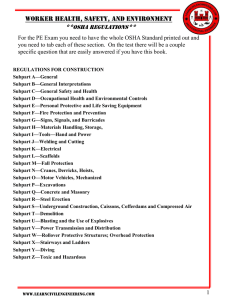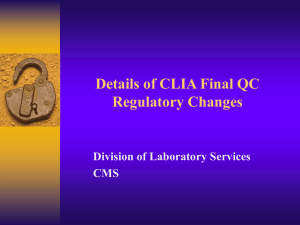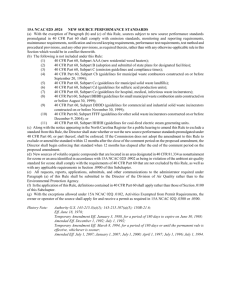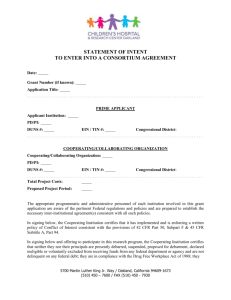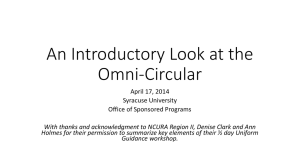United Nations
advertisement
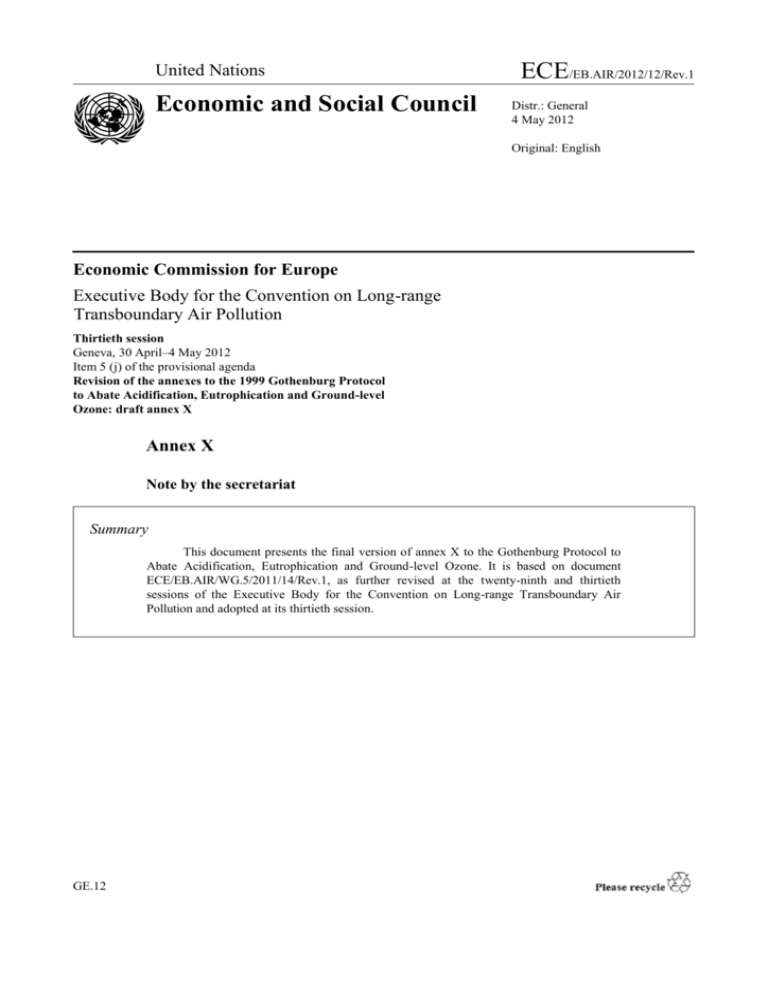
United Nations Economic and Social Council ECE/EB.AIR/2012/12/Rev.1 Distr.: General 4 May 2012 Original: English Economic Commission for Europe Executive Body for the Convention on Long-range Transboundary Air Pollution Thirtieth session Geneva, 30 April–4 May 2012 Item 5 (j) of the provisional agenda Revision of the annexes to the 1999 Gothenburg Protocol to Abate Acidification, Eutrophication and Ground-level Ozone: draft annex X Annex X Note by the secretariat Summary This document presents the final version of annex X to the Gothenburg Protocol to Abate Acidification, Eutrophication and Ground-level Ozone. It is based on document ECE/EB.AIR/WG.5/2011/14/Rev.1, as further revised at the twenty-ninth and thirtieth sessions of the Executive Body for the Convention on Long-range Transboundary Air Pollution and adopted at its thirtieth session. GE.12 ECE/EB.AIR/2012/12/Rev.1 Limit values for emissions of particulate matter from stationary sources 1. Section A applies to Parties other than Canada and the United States of America, section B applies to Canada and section C applies to the United States of America. A. Parties other than Canada and the United States of America 2. In this section only, “dust” and “total suspended particulate matter” (TSP) means the mass of particles, of any shape, structure or density, dispersed in the gas phase at the sampling point conditions which may be collected by filtration under specified conditions after representative sampling of the gas to be analysed, and which remain upstream of the filter and on the filter after drying under specified conditions. 3. For the purpose of this section, “emission limit value” (ELV) means the quantity of dust and/or TSP contained in the waste gases from an installation that is not to be exceeded. Unless otherwise specified, it shall be calculated in terms of mass of pollutant per volume of the waste gases (expressed as mg/m3), assuming standard conditions for temperature and pressure for dry gas (volume at 273.15 K, 101.3 kPa). With regard to the oxygen content of waste gas, the values given in the tables below for each source category shall apply. Dilution for the purpose of lowering concentrations of pollutants in waste gases is not permitted. Start-up, shutdown and maintenance of equipment are excluded. 4. Emissions shall be monitored in all cases via measurements or through calculations achieving at least the same accuracy. Compliance with limit values shall be verified through continuous or discontinuous measurements, type approval, or any other technically sound method including verified calculation methods. In case of continuous measurements, compliance with the limit value is achieved if the validated monthly emission average does not exceed the ELV. In case of discontinuous measurements or other appropriate determination or calculation procedures, compliance with the ELVs is achieved if the mean value based on an appropriate number of measurements under representative conditions does not exceed the value of the emission standard. The inaccuracy of measurement methods may be taken into account for verification purposes. 5. Monitoring of relevant polluting substances and measurements of process parameters, as well as the quality assurance of automated measuring systems and the reference measurements to calibrate those systems, shall be carried out in accordance with CEN standards. If CEN standards are not available, ISO standards, national or international standards which will ensure the provision of data of an equivalent scientific quality shall apply. 6. Special provisions for combustion plants referred to in paragraph 7: (a) A Party may derogate from the obligation to comply with the ELVs provided for in paragraph 7 in the following cases: (i) For combustion plants normally using gaseous fuel which have to resort exceptionally to the use of other fuels because of a sudden interruption in the supply of gas and for this reason would need to be equipped with a waste gas purification facility; 2 ECE/EB.AIR/2012/12/Rev.1 (ii) For existing combustion plants not operated more than 17,500 operating hours, starting from 1 January 2016 and ending no later than 31 December 2023. (b) Where a combustion plant is extended by at least 50 MWth, the ELV specified in paragraph 7 for new installations shall apply to the extensional part affected by the change. The ELV is calculated as an average weighted by the actual thermal input for both the existing and the new part of the plant. (c) Parties shall ensure that provisions are made for procedures relating to malfunction or breakdown of the abatement equipment. (d) In the case of a multi-fuel firing combustion plant involving the simultaneous use of two or more fuels, the ELV shall be determined as the weighted average of the ELVs for the individual fuels, on the basis of the thermal input delivered by each fuel. 7. Combustion plants with a rated thermal input exceeding 50 MWth:1 Table 1 Limit values for dust emissions from combustion plants a/ Fuel type Thermal input (MWth) Solid fuels 50–100 ELV for dust (mg/m³) b/ New plants: 20 (coal, lignite and other solid fuels) 20 (biomass, peat) Existing plants: 30 (coal, lignite and other solid fuels) 30 (biomass, peat) 100–300 New plants: 20 (coal, lignite and other solid fuels) 20 (biomass, peat) Existing plants: 25 (coal, lignite and other solid fuels) 20 (biomass, peat) >300 New plants: 10 (coal, lignite and other solid fuels) 20 (biomass, peat) 1 The rated thermal input of the combustion plant is calculated as the sum of the input of all units connected to a common stack. Individual units below 15 MWth shall not be considered when calculating the total rated thermal input. 3 ECE/EB.AIR/2012/12/Rev.1 Fuel type Thermal input (MWth) ELV for dust (mg/m³) b/ Existing plants: 20 (coal, lignite and other solid fuels) 20 (biomass, peat) Liquid fuels 50–100 New plants: 20 Existing plants: 30 (in general) 50 for the firing of distillation and conversion residues within refineries from the refining of crude oil for own consumption in combustion plants Liquid fuels 100–300 New plants: 20 Existing plants: 25 (in general) 50 for the firing of distillation and conversion residues within refineries from the refining of crude oil for own consumption in combustion plants >300 New plants: 10 Existing plants: 20 (in general) 50 for the firing of distillation and conversion residues within refineries from the refining of crude oil for own consumption in combustion plants Natural gas > 50 5 Other gases > 50 10 30 for gases produced by the steel industry which can be used elsewhere a/ 4 In particular, the ELVs shall not apply to: - Plants in which the products of combustion are used for direct heating, drying, or any other treatment of objects or materials; - Post-combustion plants designed to purify the waste gases by combustion which are not operated as independent combustion plants; - Facilities for the regeneration of catalytic cracking catalysts; - Facilities for the conversion of hydrogen sulphide into sulphur; - Reactors used in the chemical industry; ECE/EB.AIR/2012/12/Rev.1 - b/ 8. Coke battery furnaces; Cowpers; Recovery boilers within installations for the production of pulp; Waste incinerators; and Plants powered by diesel, petrol or gas engines or by combustion turbines, irrespective of the fuel used. The O2 reference content is 6% for solid fuels and 3% for liquid and gaseous fuels. Mineral oil and gas refineries: Table 2 Limit values for dust emissions released from mineral oil and gas refineries Emission source FCC regenerators 9. ELV for dust (mg/m³) 50 Cement clinker production: Table 3 Limit values for dust emissions released from cement production a/ ELV for dust (mg/m³) Cement installations, kilns, mills and clinker coolers 20 a/ Installations for the production of cement clinker in rotary kilns with a capacity >500 Mg/day or in other furnaces with a capacity >50 Mg/day. The reference oxygen content is 10 %. 10. Lime production: Table 4 Limit values for dust emissions released from lime production a/ ELV for dust (mg/m³) Lime kiln firing 20 b/ a/ Installations for the production of lime with a capacity of 50 Mg/day or more. This includes lime kilns integrated in other industrial processes, with the exception of the pulp industry (see table 9). The reference oxygen content is 11%. b/ Where the resistivity of the dust is high, the ELV may be higher, up to 30 mg/m³. 5 ECE/EB.AIR/2012/12/Rev.1 11. Production and processing of metals: Table 5 Limit values for dust emissions released from primary iron and steel production ELV for dust (mg/m³) Activity and capacity threshold Sinter plant Pelletization plant 20 for crushing, grinding and drying 15 for all other process steps Blast furnace: Hot stoves (>2.5 t/hour) 10 Basic oxygen steelmaking and casting (>2.5 t/hour) 30 Electric steelmaking and casting (>2.5 t/hour) 15 (existing) 5 (new) Table 6 Limit values for dust emissions released from iron foundries Activity and capacity threshold ELV for dust (mg/m³) Iron foundries (>20 t/day): - all furnaces (cupola, induction, rotary) - all mouldings (lost, permanent) 20 Hot and cold rolling 20 50 where a bag filter cannot be applied due to the presence of wet fumes Table 7 Limit values for dust emissions released from non-ferrous metals production and processing ELV for dust (mg/m³) (daily) Non-ferrous metal processing 6 20 ECE/EB.AIR/2012/12/Rev.1 12. Glass production: Table 8 Limit values for dust emissions released from glass production a/ ELV for dust (mg/m³) New installations 20 Existing installations 30 a/ Installations for the production of glass or glass fibres with a capacity of 20 Mg/day or more. Concentrations refer to dry waste gases at 8% oxygen by volume (continuous melting), 13% oxygen by volume (discontinuous melting). 13. Pulp production: Table 9 Limit values for dust emissions released from pulp production ELV for dust (mg/m³) (annual averages) Auxiliary boiler 40 when firing liquid fuels (at 3% oxygen content) 30 when firing solid fuels (at 6% oxygen content) Recovery boiler and lime kiln 50 14. Waste incineration: Table 10 Limit values for dust emissions released from waste incineration ELV for dust (mg/m³) Municipal waste incineration plants (> 3 Mg/hour) 10 Hazardous and medical waste incineration (> 1 Mg/hour) 10 Note: Oxygen reference: dry basis, 11%. 7 ECE/EB.AIR/2012/12/Rev.1 15. Titanium dioxide production: Table 11 Limit values for dust emissions released from titanium dioxide production ELV for dust (mg/m³) Sulphate process, total emission 50 Chloride process, total emission 50 Note: For minor emission sources within an installation, an ELV of 150 mg/m³ may be applied. 16. Combustion installations with a rated thermal input < 50 MWth: This paragraph is recommendatory in character and describes the measures that can be taken insofar as a Party considers them to be technically and economically feasible for the control of particulate matter. (a) Residential combustion installations with a rated thermal input < 500 kWth: (i) Emissions from new residential combustion stoves and boilers with a rated thermal input < 500 kWth can be reduced by the application of: (aa) Product standards as described in CEN standards (e.g., EN 303–5) and equivalent product standards in the United States and Canada. Countries applying such product standards may define additional national requirements taking into account, in particular, the contribution of emissions of condensable organic compounds to the formation of ambient PM; (bb) Ecolabels specifying performance criteria that are typically stricter than the minimum efficiency requirements of the EN product standards or national regulations; Table 12 Recommended limit values for dust emissions released from new solid fuel combustion installations with a rated thermal input < 500 kWth to be used with product standards (O2 reference content: 13%) Dust (mg/m³) Open/closed fireplaces and stoves using wood 75 Log wood boilers (with heat storage tank) 40 Pellet stoves and boilers 50 Stoves and boilers using other solid fuels than wood 50 Automatic combustion installations 50 (ii) Emissions from existing residential combustion stoves and boilers can be reduced by the following primary measures: (aa) regarding: public A 8 information and awareness-raising The proper operation of stoves and boilers; programmes ECE/EB.AIR/2012/12/Rev.1 B The use of untreated wood only; C The correct seasoning of wood for moisture content; (bb) establishing a programme to promote the replacement of the oldest existing boilers and stoves by modern appliances; or (cc) appliances. establishing an obligation to exchange or retrofit old (b) Non-residential combustion installations with a rated thermal input 100 kWth–1 MWth: Table 13 Recommended limit values for dust emissions released from boilers and process heaters with a rated thermal input of 100 kWth–1 MWth. (O2 reference content: wood, other solid biomass and peat: 13%; coal, lignite and other fossil solid fuels: 6%) Dust (mg/m³) Solid fuels 100–500 kWth New installations Existing installations Solid fuels 500 kWth–1 MWth New installations Existing installations (c) 50 150 50 150 Combustion installations with a rated thermal input > 1–50 MWth: Table 14 Recommended limit values for dust emissions released from boilers and process heaters with a rated thermal input of 1 MWth–50 MWth (O2 reference content: Wood, other solid biomass and peat: 11%; Coal, lignite and other fossil solid fuels: 6%; Liquid fuels, including liquid biofuels: 3%) Dust (mg/m³) Solid fuels > 1–5 MWth Solid fuels > 5–50 MWth Liquid fuels > 1–5 MWth Liquid fuels >5-50 MWth B. New installations 20 Existing installations 50 New installations 20 Existing installations 30 New installations 20 Existing installations 50 New installations 20 Existing installations 30 Canada 17. Limit values for controlling emissions of PM will be determined for stationary sources, as appropriate, taking into account information on available control technologies, limit values applied in other jurisdictions and the documents listed in subparagraphs (a) to (h) below. Limit values may be expressed in terms of PM or TPM. TPM in this context means any PM with an aerodynamic diameter of less than 100 µm. (a) Secondary Lead Smelter Release Regulations, SOR/91-155; 9 ECE/EB.AIR/2012/12/Rev.1 (b) Environmental Code of Practice for Base Metals Smelters and Refineries; (c) New Source Emission Guidelines for Thermal Electricity Generation; (d) Environmental Code of Practice for Integrated Steel Mills (EPS 1/MM/7); (e) Environmental (EPS 1/MM/8); (f) Code of Practice for Non-Integrated Steel Mills Emission Guidelines for Cement Kilns. PN 1284; (g) Joint Initial Actions to Reduce Pollutant Emissions that Contribute to Particulate Matter and Ground-level Ozone; and (h) Performance testing of solid-fuel-burning heating appliances, Canadian Standards Association, B415. 1-10. C. United States of America 18. Limit values for controlling emissions of PM from stationary sources in the following stationary source categories, and the sources to which they apply, are specified in the following documents: (a) Steel Plants: Electric Arc Furnaces — 40 C.F.R. Part 60, Subpart AA and Subpart AAa; (b) Small Municipal Waste Combustors — 40 C.F.R. Part 60, Subpart AAAA; (c) Kraft Pulp Mills — 40 C.F.R. Part 60, Subpart BB; (d) Glass Manufacturing — 40 C.F.R. Part 60, Subpart CC; (e) Electric Utility Steam Generating Units — 40 C.F.R. Part 60, Subpart D and Subpart Da; (f) Industrial-Commercial-Institutional Steam Generating Units — 40 C.F.R. Part 60, Subpart Db and Subpart Dc; (g) Grain Elevators — 40 C.F.R. Part 60, Subpart DD; (h) Municipal Waste Incinerators — 40 C.F.R. Part 60, Subpart E, Subpart Ea and Subpart Eb; (i) Hospital/Medical/Infectious Waste Incinerators — 40 C.F.R. Part 60, Subpart Ec; (j) Portland Cement — 40 C.F.R. Part 60, Subpart F; (k) Lime Manufacturing — 40 C.F.R. Part 60, Subpart HH; (l) Hot Mix Asphalt Facilities — 40 C.F.R. Part 60, Subpart I; (m) Stationary Internal Combustion Engines: Compression Ignition — 40 C.F.R. Part 60, Subpart IIII; 10 (n) Petroleum Refineries — 40 C.F.R. Part 60, Subpart J and Subpart Ja; (o) Secondary Lead Smelters — 40 C.F.R. Part 60, Subpart L; (p) Metallic Minerals Processing — 40 C.F.R. Part 60, Subpart LL; (q) Secondary Brass and Bronze — 40 C.F.R. Part 60, Subpart M; (r) Basic Oxygen Process Furnaces — 40 C.F.R. Part 60, Subpart N; ECE/EB.AIR/2012/12/Rev.1 (s) Basic Process Steelmaking Facilities — 40 C.F.R. Part 60, Subpart Na; (t) Phosphate Rock Processing — 40 C.F.R. Part 60, Subpart NN; (u) Sewage Treatment Plant Incineration — 40 C.F.R. Part 60, Subpart O; (v) Nonmetallic Minerals Processing Plants — 40 C.F.R. Part 60, Subpart OOO; (w) Primary Copper Smelters — 40 C.F.R. Part 60, Subpart P; (x) Ammonium Sulfate Manufacturing — 40 C.F.R. Part 60, Subpart PP; (y) Wool Fiberglass Insulation — 40 C.F.R. Part 60, Subpart PPP; (z) Primary Zinc Smelters — 40 C.F.R. Part 60, Subpart Q; (aa) Primary Lead Smelters — 40 C.F.R. Part 60, Subpart R; (bb) Primary Aluminum reduction plants — 40 C.F.R. Part 60, Subpart Subpart S; (cc) Phosphate Fertilizer Production — 40 C.F.R. Part 60, Subparts T, U, V, W, X; (dd) Asphalt Processing and Asphalt Roofing Manufacturing — 40 C.F.R. Part 60, Subpart UU; (ee) Calciners and Dryers in Mineral Industries — 40 C.F.R. Part 60, Subpart UUU; (ff) Coal Preparation Plants — 40 C.F.R. Part 60, Subpart Y; (gg) Ferroalloy Production Facilities — 40 C.F.R. Part 60, Subpart Z; (hh) Residential Wood Heaters — 40 C.F.R. Part 60, Subpart AAA; (ii) Small Municipal Waste Combustors (after 11/30/1999) — 40 C.F.R. Part 60, Subpart AAAA; (jj) Small Municipal Waste Combustors (before 11/30/1999) — 40 C.F.R. Part 60, Subpart BBBB; (kk) Other Solid Waste Incineration Units (after 12/9/2004) — 40 C.F.R. Part 60, Subpart EEEE; (ll) Other Solid Waste Incineration Units (before 12/9/2004) — 40 C.F.R. Part 60, Subpart FFFF; (mm) Stationary Compression Ignition Internal Combustion Engines — 40 C.F.R. Part 60, Subpart IIII; and (nn) Lead Acid BatteryManufacturing Plants — 40 C.F.R. Part 60, Subpart KK. 19. Limit values for controlling emissions of PM from sources subject to National Emission Standards for Hazardous Air Pollutants: (a) (b) Subpart N; Coke oven batteries — 40 C.F.R. Part 63, Subpart L; Chrome Electroplating (major and Area sources) – 40 C.F.R. Part 63, (c) Secondary lead smelters — 40 C.F.R. Part 63, Subpart X; (d) Phosphoric Acid Manufacturing Plants — 40 C.F.R. Part 63, Subpart AA; (e) Phosphate Fertilizers Production Plants — 40 C.F.R. Part 63, Subpart BB; (f) Magnetic Tape Manufacturing — 40 C.F.R. Part 63, Subpart EE; (g) Primary Aluminum— 40 C.F.R. Part 63, Subpart L; 11 ECE/EB.AIR/2012/12/Rev.1 (h) Pulp and paper II (combustion) — 40 C.F.R. Part 63, Subpart MM; (i) Mineral wool manufacturing — 40 C.F.R. Part 63, Subpart DDD; (j) Hazardous waste combustors — 40 C.F.R. Part 63, Subpart EEE; (k) Portland cement manufacturing — 40 C.F.R. Part 63, Subpart LLL; (l) Wool fiberglass manufacturing — 40 C.F.R. Part 63, Subpart NNN; (m) Primary copper — 40 C.F.R. Part 63, Subpart QQQ; (n) Secondary aluminum — 40 C.F.R. Part 63, Subpart RRR; (o) Primary lead smelting — 40 C.F.R. Part 63, Subpart TTT; (p) Petroleum refineries — 40 C.F.R. Part 63, Subpart UUU; (q) Ferroalloys production — 40 C.F.R. Part 63, Subpart XXX; (r) Lime manufacturing — 40 C.F.R. Part 63, Subpart AAAAA; (s) Coke Ovens: Pushing, Quenching, and Battery Stacks — 40 C.F.R. Part 63, Subpart CCCCC; (t) Iron and steel foundries — 40 C.F.R. Part 63, Subpart EEEEE; (u) Integrated Subpart FFFFF; (v) iron and steel manufacturing — 40 C.F.R. Part 63, Site remediation — 40 C.F.R. Part 63, Subpart GGGGG; (w) Miscellaneous Subpart HHHHH; coating manufacturing — 40 C.F.R. Part 63, (x) Asphalt Processing and Roofing Manufacturing — 40 C.F.R. Part 63, Subpart LLLLL; (y) Taconite Iron Ore Processing — 40 C.F.R. Part 63, Subpart RRRRR; (z) Refractory products manufacturing — 40 C.F.R. Part 63, Subpart SSSSS; (aa) Primary magnesium refining — 40 C.F.R. Part 63, Subpart TTTTT; (bb) Electric Arc Furnace Steelmaking Facilities — 40 C.F.R. Part 63, Subpart YYYYY; (cc) Iron and steel foundries — 40 C.F.R. Part 63, Subpart ZZZZZ; (dd) Primary Copper Smelting Area Sources Subpart EEEEEE; — 40 C.F.R. Part 63, (ee) Secondary Copper Smelting Area Sources — 40 C.F.R. Part 63, Subpart FFFFFF; (ff) Primary Nonferrous Metals Area Sources: Zinc, Cadmium, and Beryllium — 40 C.F.R. Part 63, Subpart GGGGGG; (gg) Lead Acid Battery Manufacturing (Area sources) — 40 C.F.R. Part 63, Subpart PPPPPP; (hh) Glass manufacturing (area sources) — 40 C.F.R. Part 63, Subpart SSSSSS; (ii) Secondary Nonferrous Metal Smelter (Area Sources) — 40 C.F.R. Part 63, Subpart TTTTTT; (jj) Chemical Subpart VVVVVV; 12 Manufacturing (Area Sources) — 40 C.F.R. Part 63, ECE/EB.AIR/2012/12/Rev.1 (kk) Plating and Polishing Operations (Area sources) — 40 C.F.R. Part 63, Subpart WWWWWW; (ll) Area Source Standards for Nine Metal Fabrication and Finishing Source Categories — 40 C.F.R.Part 63, Subpart XXXXXX; (mm) Ferroalloys Subpart YYYYYY; Production (Area Sources) — 40 C.F.R. Part 63, (nn) Aluminum, Copper, and Nonferrous Foundries (Area Sources) — 40 C.F.R. Part 63, Subpart ZZZZZZ; (oo) Asphalt Processing and Roofing Manufacturing (Area Sources) — 40 C.F.R. Part 63, Subpart AAAAAAA; (pp) Chemical Subpart BBBBBBB; Preparation (Area Sources) — 40 C.F.R. Part 63, (qq) Paints and Allied Products Manufacturing (Area Sources) — 40 C.F.R. Part 63, Subpart CCCCCCC; (rr) Prepared animal feeds manufacturing (Area Sources) — 40 C.F.R. Part 63, Subpart DDDDDDD; and (ss) Gold Mine Ore Processing and Production (Area Sources) — 40 C.F.R. Part 63, Subpart EEEEEEE. 13



